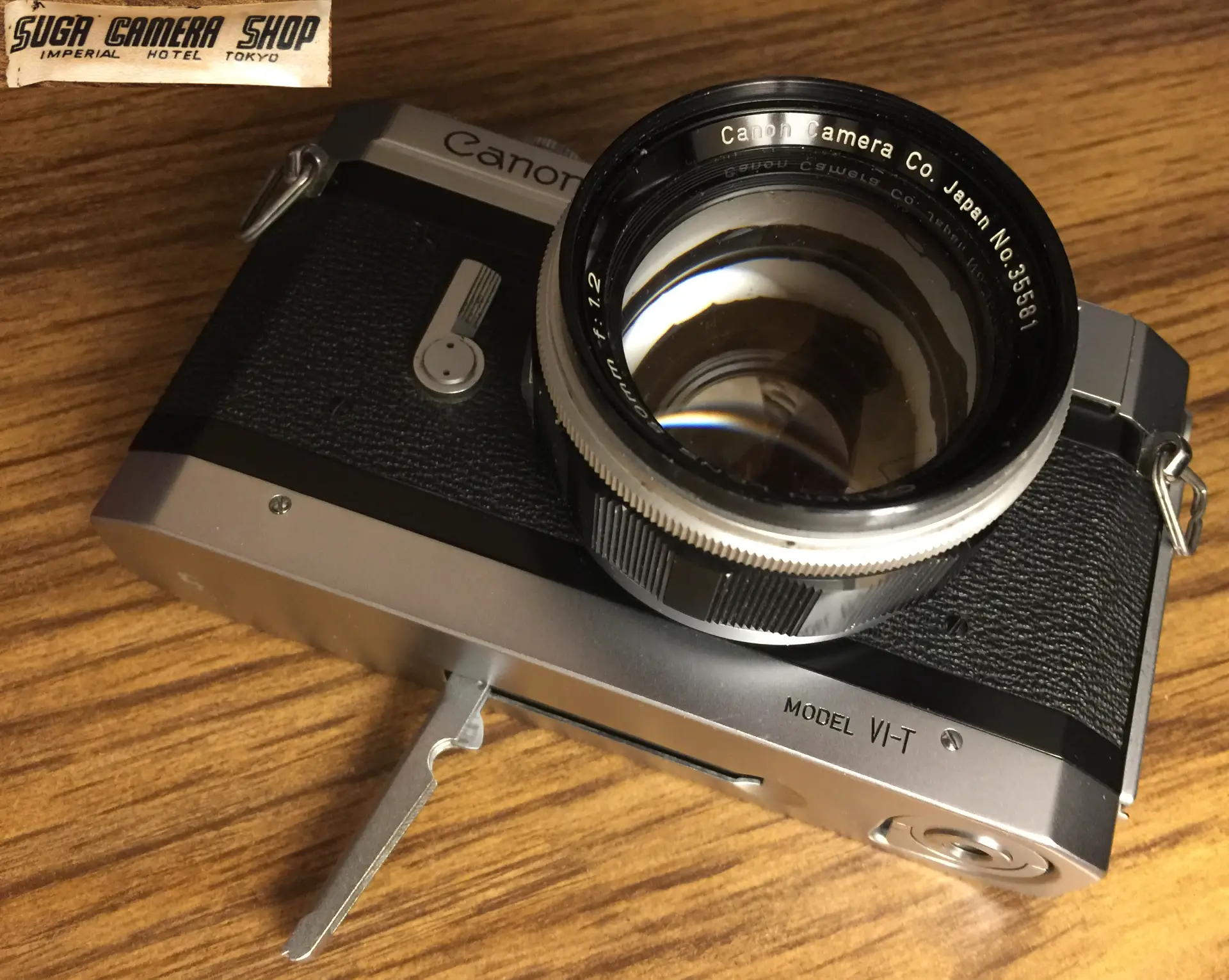What makes a camera treasured? Often, it was owned by a family member. Or it may simply become an invaluable part of a photographer’s arsenal. This beautiful, tank-like, Canon VI-T rangefinder was neither. In fact I almost sold it for parts on “the ‘Bay.” But quickly decided not to.
A Flawed Beauty
I paid just $5 for it at a garage sale around 30 years ago. It looked beautiful, and the left-handed Trigger Winder in its base plate (extended in the photo) still seemed to work. But all wasn’t as rosy as I first thought:
- Its 50mm f:1.2 M39 lens seemed beautifully clean, but when I looked through it at a bright light, I saw an almost invisible haze of fine cleaning scratches on its rear element.
- And when I tried to run some film through it anyway, the Trigger Winder stopped advancing after only six frames. It slid uselessly from side to side with no resistance from the internal film-advance train.
The lens, however, is nicely compact for an f/1.2. So I adapted it for use on my Fuji X-Pro 1. And if I don’t shoot into bright light, its faint cleaning scratches don’t appear to be a problem.
But because of that winder, I began to prepare a “parts/repair” listing for the VI-T’s body. That is, until I opened it to photograph the interior, and out fell an old curled sticker whose glue had dried long ago (inset in photo). I quickly changed my mind.
From Tokyo with Love
The label says “Suga Camera Shop/Imperial Hotel Tokyo.” I’d never heard of the Suga shop… but the Imperial Hotel was famous in architectural circles. I’ve given up trying to untangle the description of Frank Lloyd Wright’s involvement with the place in the above Wiki page. Best to just say that the hotel was initially built in 1890… and after various fires and earthquakes, Wright and associates built a new one that officially opened in 1923.
And it almost immediately survived the “Great Tokyo Earthquake” of the same year… though its central section slumped and several floors bulged. The hotel’s main failing, though, was its foundation. To shield it from earthquake shaking, Wright had put the massively huge complex on broad, shallow footings that would theoretically “float” on the site’s alluvial mud “as a battleship floats on water.” But the footings weren’t enough to keep the hotel from sinking into the mud over the decades, and after portions had submerged by up to 43 inches, it was demolished in 1967 and replaced by a modern highrise.
FUN FACT: Wright’s version employed the same “Maya Revival Style” that he used in several Los Angeles homes. You can see one of them– the famous Ennis House— early in Vincent Price’s “House on Haunted Hill.” It’s the gloomy night castle that Price’s ill-fated party guests cruise up to in their limos. For the movie, however, studio artists added a tall central tower that isn’t really there.
Souvenir of Wright’s Imperial
Some larger areas of Wright’s Imperial Hotel were rebuilt in a nearby museum… and other smaller sections are retained in today’s modern highrise. But he’s my favorite architect of all time. And several facts seem to point to an interesting conclusion:
- Canon introduced the VI-T camera and f:1.2 lens in 1958.
- According to Wikipedia, only 8,175 VI-Ts were sold (from June 1958 to July 1960).
- The camera reportedly sold much better in Japan than the U.S.
- And Wright’s Imperial Hotel was demolished in 1967.
So there’s a decent chance that my VI-T was purchased in Wright’s building before it was demolished. And though I’ve visited the architect’s Fallingwater and nearby Kentuck Knob in Pennsylvania, this camera is as close as I’ll probably ever get to his spectacular Imperial Hotel.
Epilogue
In the years since I decided to keep the camera, I exercised the Trigger Winder whenever I entered my office. And just this year, it re-engaged with the film’s drive train! So I’ll again run some film and post a “5-Frames” piece about it.
But before I do, I may also try a highly un-intuitive fix for those cleaning scratches on the lens. I once successfully used the trick on an antique mirror from which someone may have used steel wool to removed sticker gum. A small area of its glass had a similar haze of fine scratches, and the odd fix was to rub some colorless, neutral shoe polish into the area and then keep buffing it off until the greasy smear disappeared. It (theoretically) worked because the polish has nearly the same index of refraction as glass… and the scratches on our antique mirror are still invisible eight years on. Maybe…?!
–Dave Powell is a Westford, Mass., writer and avid amateur photographer.
Share this post:









Comments
Art Meripol on Canon VI-T (a Tale of a Treasured Camera)
Comment posted: 10/05/2023
Comment posted: 10/05/2023
Michael Avison on Canon VI-T (a Tale of a Treasured Camera)
Comment posted: 10/05/2023
Comment posted: 10/05/2023
Comment posted: 10/05/2023
Simon on Canon VI-T (a Tale of a Treasured Camera)
Comment posted: 11/05/2023
Comment posted: 11/05/2023
Christopher M. on Canon VI-T (a Tale of a Treasured Camera)
Comment posted: 12/05/2023
Dying to see images from your unicorn, especially after "polishing" the glass! Happy shooting...
Comment posted: 12/05/2023
Jim Race on Canon VI-T (a Tale of a Treasured Camera)
Comment posted: 22/06/2023
Comment posted: 22/06/2023